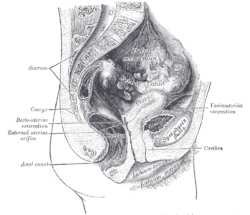Rectouterine pouch
| Rectouterine pouch | |
|---|---|
 Sagittal section of the lower part of a female trunk, right segment. (Excavatio recto-uterina labeled at bottom right.) | |
 Median sagittal section of female pelvis. (Rectouterine excavation labeled at center left.) | |
| Details | |
| Identifiers | |
| Latin | excavatio rectouterina, cavum douglassi, fossa douglasi |
| MeSH | D004312 |
| TA98 | A10.1.02.512F |
| TA2 | 3726 |
| FMA | 14728 |
| Anatomical terminology | |
The rectouterine pouch, pouch of Douglas, or rectovaginal pouch is the extension of the peritoneum between the rectum and the posterior wall of the uterus in the human female. Its anterior boundary is formed by the posterior fornix of the vagina.[1]
Structure[]
In women, the rectouterine pouch is the deepest point of the peritoneal cavity. It lies posterior to the uterus and anterior to the rectum.[2] (The pouch on the other side of the uterus is the vesicouterine pouch.) It is near the posterior fornix of the vagina.
It is normal to have approximately 1 to 3 ml (or mL) of fluid in the rectouterine pouch throughout the menstrual cycle.[3] After ovulation there is between 4 and 5 ml of fluid in the rectouterine pouch.[3]
In men, the region corresponding to the rectouterine pouch is the rectovesical pouch, which lies between the urinary bladder and rectum.
Clinical significance[]
The rectouterine pouch, being the lowest part of the peritoneal cavity in a woman at supine position, is a common site for the spread of pathology such as ascites, tumour, endometriosis, pus, etc.
As it is the furthest point of the abdominopelvic cavity in women, it is a site where infection and fluids typically collect.[4]
The rectouterine pouch can be used in the treatment of end-stage kidney failure in patients who are treated by peritoneal dialysis. The tip of the dialysis catheter is placed into the deepest point of the pouch.
Culdocentesis[]
Culdocentesis is a procedure that draws fluid from the pouch, by way of the vagina using a needle. Fluid drawn using a scapel incision is called a colpotomy.
Naming and etymology[]
The rectouterine (or recto-uterine) pouch is also called the rectouterine excavation, uterorectal pouch, rectovaginal pouch, pouch of Douglas (after anatomist James Douglas, 1675–1742), Douglas pouch,[5] Douglas cavity,[5] Douglas space,[5] Douglas cul-de-sac,[5] Ehrhardt–Cole recess, Ehrhardt–Cole cul-de-sac, cavum Douglasi, or excavatio rectouterina. The combining forms reflect the rectum (recto-, -rectal) and uterus (utero-, -uterine).
In Obstetrics and gynaecology, it is commonly referred to as the pouch of Douglas or the posterior cul-de-sac.[6]
The Douglas fold (rectouterine plica), Douglas line, and Douglas septum are likewise named after the same James Douglas.
In popular culture[]
The Pouch of Douglas was featured in the Netflix special Hannah Gadsby: Douglas to deconstruct patriarchy.[7]
Additional images[]

The epiploic foramen, greater sac or general cavity (red) and lesser sac, or omental bursa (blue).

Illu female pelvis
See also[]
- Dolichodouglas
- Vesicouterine excavation
References[]
- ^ Vasu, Balaji. "Rectouterine pouch | Radiology Reference Article | Radiopaedia.org". Radiopaedia. Retrieved 27 September 2021.
- ^ Woodward, Paula J.; Griffith, James F.; Antonio, Gregory E.; Ahuja, Anil T., eds. (2018-01-01), "Ureters and Bladder", Imaging Anatomy: Ultrasound (Second Edition), Elsevier, pp. 424–433, ISBN 978-0-323-54800-7, retrieved 2021-02-03
- ^ a b Severi FM, Bocchi C, Vannuccini S, Petraglia F (2012). "Ovary and ultrasound: from physiology to disease" (PDF). Archives of Perinatal Medicine. 18 (1): 7–19.
- ^ Drake, RL (2010). Gray's Anatomy for Students. Churchill Livingstone. p. 460.
- ^ a b c d synd/2937 at Who Named It?
- ^ Hensen, Jan-Hein J.; Puylaert, Julien B. C. M. (2009-06-01). "Endometriosis of the Posterior Cul-De-Sac: Clinical Presentation and Findings at Transvaginal Ultrasound". American Journal of Roentgenology. 192 (6): 1618–1624. doi:10.2214/AJR.08.1807. ISSN 0361-803X. PMID 19457826.
- ^ Hannah Gadsby: Douglas review Rolling Stone
Further reading[]
- Gullmo A (1980). "Herniography. The diagnosis of hernia in the groin and incompetence of the pouch of Douglas and pelvic floor". Acta Radiologica. Supplementum. 361: 1–76. PMID 6297246.
- Anaf V, Simon P, El Nakadi I, Simonart T, Noel J, Buxant F (February 2001). "Impact of surgical resection of rectovaginal pouch of douglas endometriotic nodules on pelvic pain and some elements of patients' sex life". The Journal of the American Association of Gynecologic Laparoscopists. 8 (1): 55–60. doi:10.1016/s1074-3804(05)60549-x. PMID 11172115.
- Baessler K, Schuessler B (March 2000). "The depth of the pouch of Douglas in nulliparous and parous women without genital prolapse and in patients with genital prolapse". American Journal of Obstetrics and Gynecology. 182 (3): 540–4. doi:10.1067/mob.2000.104836. PMID 10739505.
- Ostör AG, Nirenberg A, Ashdown ML, Murphy DJ (June 1994). "Extragenital adenosarcoma arising in the pouch of Douglas". Gynecologic Oncology. 53 (3): 373–5. doi:10.1006/gyno.1994.1151. PMID 8206414.
- Tsin, DA (2001). "Culdolaparoscopy: a preliminary report". JSLS. 5 (1): 69–71. PMC 3015410. PMID 11303998.
External links[]
- Anatomy photo:43:02-0300 at the SUNY Downstate Medical Center - "The Female Pelvis: Distribution of the Peritoneum in the Female Pelvis"
- Anatomy image:9610 at the SUNY Downstate Medical Center
- Anatomy image:9737 at the SUNY Downstate Medical Center
- Douglas'+Pouch at the US National Library of Medicine Medical Subject Headings (MeSH)
- peritoneum at The Anatomy Lesson by Wesley Norman (Georgetown University)
- figures/chapter_35/35-8.HTM: Basic Human Anatomy at Dartmouth Medical School
- "Anatomy diagram: 03281.000-2". Roche Lexicon - illustrated navigator. Elsevier. Archived from the original on 2015-06-11.
- Pelvis

